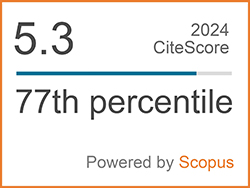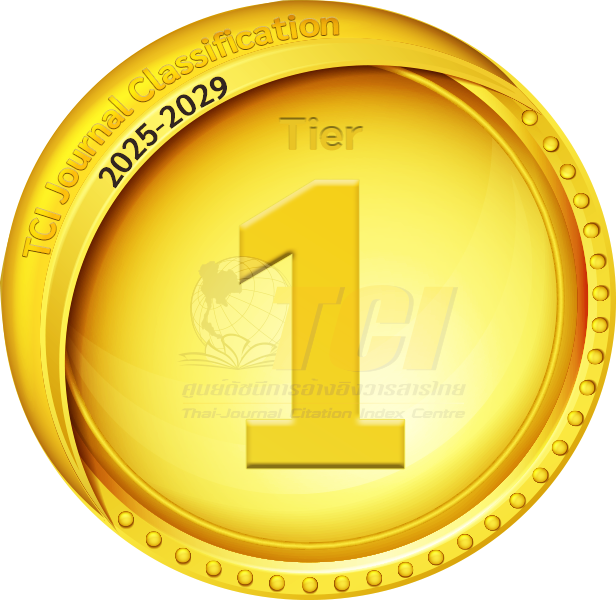Eco-Friendly Au@Al-MOF Nanocomposites Fabricated with Eleutherine bulbosa Extract for Mercury Detection in Cosmetic Product
Abstract
Keywords
[1] M. Guo, J. Wang, R. Du, Y. Liu, J. Chi, X. He, K. Huang, Y. Luo, and W. Xu, “A test strip platform based on a whole-cell microbial biosensor for simultaneous on-site detection of total inorganic mercury pollutants in cosmetics without the need for predigestion,” Biosensors and Bioelectronics, vol. 150, p. 111899, 2020.
[2] H. Cheng, F. Yi, J. Sun, A. Li, X. Zhang, D. Guan, Y. Qu, and J. Cao, “A naphthalimide-based fluorescent probe with a benzoylthiourea trigger for detection of Hg(II) in cosmetics,” Dye and Pigment, vol. 226, p. 112135, 2024.
[3] A. Khatoon, J. A. Syed, A. R. Solangi, A. Mallah, and Sirajuddin, “Mechanistic insights of mercury ion detection and its influence on time monitored hydrodynamic size of Capsicum Annumm C derived silver nanoparticles during colorimetric nano-sensing,” Optik, vol. 325, 2025, Art. no. 172237.
[4] M. Talat, P. Tripathi, and O. N. Srivastava, “Highly sensitive electrochemical detection of mercury present in the beauty creams using graphene modified glassy carbon electrode,” Innovation in Corrosion and Materials Science, vol. 8, no. 1, pp. 24–31, 2018.
[5] S. Liu, J. Zhang, Y. Wu, X. Guo, X. Wang, and X. Yu, “Highly sensitive and selective detection of mercury ions using a DNA modified fiber micro-cavity biosensor,” Microchemical Journal, vol. 212, 2025, Art. no. 113179.
[6] A. Almahri and N. M. El-Metwaly, “Smartphone-enabled mesoporous silica nanotube chemosensors for quick and selective mercury detection in water and cosmetics,” Arabian Journal of Chemistry, vol. 17, no. 10, 2024, Art. no. 105984.
[7] Y. Zhang, X. Zhao, L. Jin, W. Xu, X. Shao, Y. Liu, Y. Chen, and F. Rosei, “Gold nanoparticles-wood nanohybrid as peroxidase-like for simple and selective detection of mercury ion,” Spectrochimica Acta Part A: Molecular and Biomolecular Spectroscopy, vol. 332, 2025, Art. no. 125804.
[8] X. Y. Liu, Z. L. Zhao, T. T. Hao, and X. Li, “A simply visual and rapidly colorimetric detection of Hg2+ in cosmetics based on gold nanoparticles modified by sulfadiazine,” Optical Materials, vol. 137, 2023, Art. no. 113622.
[9] G. Fadillah, E. N. Inayatussholeha, and R. Hidayat, “Green-AgNPs modified membrane for monitoring mercury ions in cosmetic sample using pre-concentration assisted voltammetry technique,” Indonesian Journal of Chemical Analysis, vol. 7, no. 1, pp. 34–42, 2024.
[10] Z. Y. Chen, A. Gupta, and S. Chattopadhyay, “Detection of mercury in spiked cosmetics by surface enhanced Raman spectroscopy using silver shelled iron oxide nanoparticles,” Sensors and Actuators B: Chemical, vol. 337, 2021, Art. no. 129788.
[11] T. Fu, W. Li, H. Wen, L. Kong, M. Zheng, L. Ma, W. Guo, Z. Meng, X. Zhang, X. Zhang, W. Gong, L. Cai, M. Jin, K. Liu, B. Zhu, and W. Sheng, “Biocompatibility evaluation and imaging application of a new fluorescent chemodosimeter for the specific detection of mercury ions in environmental and biological samples,” Microchemical Journal, vol. 207, 2024, Art. no. 111859.
[12] Y. S. Ridwan, Y. W. Hartati, and M. Sriariyanun, “Progressions in modified graphite electrodes with green nanostructured materials for low cost and sustainable electrochemical detection of environmental contaminants,” Applied Science and Engineering Progress, vol. 18, no. 2, 2025, Art. no. 7680, doi: 10.14416/j.asep.2024.10.006.
[13] H. Kim, S. Yoo, S. Kim, H. S. Lee, T. J. Lee, and S. Lee, “Colorimetric detection and automatic quantitative analysis of mercury(II) ions via selective redox reaction sites on silver-coated gold nanorods,” Sensors and Actuators Reports, vol. 9, 2025, Art. no. 100256.
[14] P. Aiemderm, K. Monkhang, S. Wongjard, K. Choowongkomon, and N. M. Swainson, “Advantages of electro-deposited gold on carbon electrodes for nt-probnp immunosensor for development of heart failure test kit,” Applied Science and Engineering Progress, vol. 17, no. 2, 2024, Art. no. 7004, doi: 10.14416/j.asep.2023. 10.004.
[15] U. Farahdina, M. Firdhaus, P. Wulandari, A. Rubiyanto, and N. Nasori, “Electrochemical characterization of thin film/nanodots electrodes of silver and gold for biosensing CCRF-CEM leukemia cells,” Applied Science and Engineering Progress, vol. 18, no. 1, 2025, Art. no. 7529, doi: 10.14416/j.asep.2024.09.003.
[16] Y. Faramitha, F. Dimawarnita, I. Kresnawati, H. Aqoma, A. Ferdiansyah, and A. F. Nugraha, “Facile synthesis of glutathione-copper nanoparticles for 3-monochloropropanediol colorimetric detection,” Applied Science and Engineering Progress, vol. 18, no. 2, 2025, Art. no. 7621, doi: 10.14416/j.asep.2024.11.005.
[17] K. Krishna and Y. Sangappa, “Silver nanoparticles-loaded polyvinyl alcohol nanocomposite film strips for environmental mercury detection application,” Inorganic Chemistry Communications, vol. 175, 2025, Art. no. 114138.
[18] M. R. Kumalasari, Z. Pereiz, and C. Chuchita, “Pengaruh pH agen pereduksi serin terhadap sintesis nanopartikel emas,” Comserva, vol. 2, no. 12, pp. 2912–2918, 2023.
[19] M. M. Martin and R. E. Sumayao, “Facile green synthesis of silver nanoparticles using rubus rosifolius linn aqueous fruit extracts and its characterization,” Applied Science and Engineering Progress, vol. 15, no. 3, 2022, Art. no. 5511, doi: 10.14416/j.asep.2021.10.011.
[20] G. Prasanth, M. G. Madhu, N. Kottam, and S. S. P. Nai, “Carica papaya-derived carbon nanodots for the detection of Fe(III) ions,” Applied Science and Engineering Progress, vol. 18, no. 2, 2025, Art. no. 7571, doi: 10.14416/j.asep.2024.09.005.
[21] V. D. Doan, A. T. Thieu, T. D. Nguyen, V. C. Nguyen, X. T. Cao, T. L. H. Nguyen, V. T. Le, “Biosynthesis of gold nanoparticles using litsea cubeba fruit extract for catalytic reduction of 4-nitrophenol,” Journal of Nanomaterials, vol. 2020, no. 1, 2020, Art. no. 4548790.
[22] M. Hosny, M. Fawzy, Y. A. El-Badry, E. E. Hussein, and A. S. Eltaweil, “Plant-assisted synthesis of gold nanoparticles for photocatalytic, anticancer, and antioxidant applications,” Journal of Saudi Chemical Society, vol. 26, no. 2, 2022, Art. no. 101419.
[23] N. Rahayu, G. Gusrizal, and N. Nurlina, “Ekstrak umbi bawang dayak (Eleutherine palmifolia (l.) Merr.) Sebagai pereduksi ion perak dalam sintesis nanopartikel perak,” The Indonesian Journal of Pure and Applied Chemistry, vol. 3, no. 3, p. 17, 2021.
[24] S. U. M. Beladona, A. Rochliadi, and A. Patah, “A facile synthesis of hkust-1 MOF through reductive electrosynthesis method,” Key Engineering Material, vol. 874, pp. 3–12, 2021.
[25] L. Bai, A. Jana, H. P. Tham, K. T. Nguyen, P. Borah, and Y. Zhao, “Remarkable vapochromic behavior of pure organic octahedron embedded in porous frameworks,” Small, vol. 12, no. 24, pp. 3302–3308, 2016.
[26] Y. Feng, Y. Wang, and Y. Ying, “Structural design of metal–organic frameworks with tunable colorimetric responses for visual sensing applications,” Coordination Chemistry Reviews, vol. 446, 2021, Art. no. 214102.
[27] Z. Su, M. Chen, T. A. Okamura, M. S. Chen, S. S. Chen, and W. Y. Sun, “Reversible single-crystal-to-single-crystal transformation and highly selective adsorption property of three-dimensional cobalt(II) frameworks,” Inorganic Chemistry, vol. 50, no. 3, pp. 985–991, 2011.
[28] T. Devic and C. Serre, “High valence 3p and transition metal based MOFs,” Chemical Society Reviews, vol. 43, no. 16, pp. 6097–6115, 2014.
[29] W. Fan, K.Y. Wang, C. Welton, L. Feng, X. Wang, X. Liu, Y. Li, Z. Kang, H.C. Zhou, R. Wang, and D. Sun, “Aluminum metal–organic frameworks: From structures to applications,” Coordination Chemistry Reviews, vol. 489, 2023, Art. no. 215175.
[30] T. Loiseau, C. Volkringer, M. Haouas, F. Taulelle, and G. Férey, “Crystal chemistry of aluminium carboxylates: From molecular species towards porous infinite three-dimensional networks,” Comptes Rendus Chimie, vol. 18, no. 12, pp. 1350–1369, 2015.
[31] Y. hua, Y. Ahmadi, and K. H. Kim, “Novel strategies for the formulation and processing of aluminum metal-organic framework-based sensing systems toward environmental monitoring of metal ions,” Journal of Hazardous Materials, vol. 444, 2023, Art. no. 130422.
[32] A. Samokhvalov, “Aluminum metal–organic frameworks for sorption in solution: A review,” Coordination Chemistry Reviews, vol. 374, pp. 236–253, 2018.
[33] A. Radwan, I. M. El-Sewify, A. Shahat, H. M. E. Azzazy, M. M. H. Khalil, and M. F. El-Shahat, “Multiuse Al-MOF chemosensors for visual detection and removal of mercury ions in water and skin-whitening cosmetics,” ACS Sustainable Chemistry & Engineering, vol. 8, no. 40, pp. 15097–15107, 2020.
[34] O. Alaysuy, A. Q. Alorabi, M. M. Aljohani, A. A. Alluhaybi, R. M. Snari, N. S. Bedowr, R. Shah, and N. M. El-Metwaly, “Aluminum MOF-based sensor for simultaneous colorimetric and fluorometric detection of Co2+ in electroplating wastewater samples and recovery of Pd2+ ions from electronic wastes,” Journal of Water Process Engineering, vol. 59, 2024, Art. no. 104993.
[35] A. Shahat, S. A. Elsalam, J. M. Herrero-Martínez, E. F. Simó-Alfonso, and G. Ramis-Ramos, “Optical recognition and removal of Hg(II) using a new self-chemosensor based on a modified amino-functionalized Al-MOF,” Sensors and Actuators B: Chemical, vol. 253, pp. 164–172, 2017.
[36] W. Abd El-Fattah, E. S. Al-Farraj, N. Ben Hamadi, A. Alharbi, and A. Shahat, “Functionalized MOF as a sensitive spectroscopic probe for Hg2+, Co2+, and Al3+ ions detection in aqueous media,” ACS Omega, vol. 7, no. 20, pp. 17483–17491, 2022.
[37] A. Nurul, N. Wahidah, P. Dwi, D. Nurmarlina, and S. Elfa, “Modification of screen printed carbon electrode-gold nanoparticles (SPCE-AuNPS) for mercury detection in cosmetics,” Indonesian Journal of Chemical Analysis, vol. 07, no. 02, pp. 98–107, 2024.
[38] R. Khandanlou, V. Murthy, and H. Wang, “Gold nanoparticle-assisted enhancement in bioactive properties of Australian native plant extracts, Tasmannia lanceolata and Backhousia citriodora,” Materials Science and Engineering: C, vol. 112, 2020, Art. no. 110922.
[39] S. Krishnamurthy, A. Esterle, N. C. Sharma, and S. V. Sahi, “Yucca-derived synthesis of gold nanomaterial and their catalytic potential,” Nanoscale Research Letters, vol. 9, no. 1, pp. 1–9, 2014.
[40] T. Loiseau, C. Serre, C. Huguenard, G. Fink, F. Taulelle, M. Henry, T. Bataille, and G. Férey, “A rationale for the large breathing of the porous aluminum terephthalate (MIL-53) upon hydration,” Chemistry – A European Journal, vol. 10, no. 6, pp. 1373–1382, 2004.
[41] X. Qian, B. Yadian, R. Wu, Y. Long, K. Zhou, B. Zhu, and Y. Huang, “Structure stability of metal-organic framework MIL-53 (Al) in aqueous solutions,” International Journal of Hydrogen Energy, vol. 38, no. 36, pp. 16710–16715, 2013.
[42] W. Wong-Ng, H. G. Nguyen, L. Espinal, D. W. Siderius, and J. A. Kaduk, “Powder X-ray structural studies and reference diffraction patterns for three forms of porous aluminum terephthalate, MIL-53(A1),” Powder Diffractions, vol. 34, no. 3, pp. 216–226, 2019.
[43] A. Khodayari and S. Sohrabnezhad, “Fabrication of MIL-53(Al)/Ag/AgCl plasmonic nanocomposite: An improved metal organic framework based photocatalyst for degradation of some organic pollutants,” Journal of Solid State Chemistry, vol. 297, 2021, Art. no. 122087.
[44] C. S. Eguico, M. M. Abanto, H. T. Cendaña, D. A. P. Famero, K. B. Pediongco, A. D. C. Evangelista, and R. V. D. C. Rubi, “Sonophotopythochemical functionalization of graphene oxide - Al - Zn bimetal nanocomposite for corrosion inhibition,” Applied Science and Engineering Progress, vol. 18, no. 2, 2025, Art. no. 7618, doi: 10.14416/j.asep.2024.10.004.
[45] S. Vijayakumar, “Eco-friendly synthesis of gold nanoparticles using fruit extracts and in vitro anticancer studies,” Journal of Saudi Chemical Society, vol. 23, no. 6, pp. 753–761, 2019.
[46] M. Sepahvand, F. Buazar, and M. H. Sayahi, “Novel marine-based gold nanocatalyst in solvent-free synthesis of polyhydroquinoline derivatives: Green and sustainable protocol,” Applied Organometallic Chemistry, vol. 34, no. 12, 2020, doi: 10.1002/aoc.6000.
[47] S. M. Abbas and S. M. Al-Jubouri, “ZrO2 nanoparticles filler-based mixed matrix polyethersulfone/cellulose acetate microfiltration membrane for oily wastewater separation,” Applied Science and Engineering Progress, vol. 18, no. 1, 2025, Art. no. 7599, doi: 10.14416/j.asep.2024.10.001.
[48] K.P. T. Dang, T. T.G. Nguyen, T.D. Cao, V.D. Le, C.H. Dang, N. P. H. Duy, P. T. T. Phuong, D. M. Huy, T. T. K. Chi, and T. D. Nguyen, “Biogenic fabrication of a gold nanoparticle sensor for detection of Fe3+ ions using a smartphone and machine learning,” RSC Advances, vol. 14, no. 29, pp. 20466–20478, 2024.
[49] H. Li, J. Yang, R. Han, Y. Wang, X. Han, S. Wang, and M. Pan, “Magnetic-fluorescent immunosensing platform applying AuNPs heterogeneous MIL-53(Al) composite for efficient detection of zearalenone,” Food Chemistry, vol. 433, 2024, Art. no. 137369.
[50] H. Sulistyarti, M. M. Utama, A. M. Fadhila, A. Cahyaningrum, R. J. Murti, and A. Febriyanti, “Green synthesis of silver nanoparticles using Coffea canephora fruit skin extract and its application for mercury detection in face cream samples,” Analytical Sciences, vol. 39, no. 3, pp. 335–346, 2023.DOI: 10.14416/j.asep.2025.06.006
Refbacks
- There are currently no refbacks.
 Applied Science and Engineering Progress
Applied Science and Engineering Progress







